SUBARU BAJA 2003 1.G Repair Manual
Manufacturer: SUBARU, Model Year: 2003, Model line: BAJA, Model: SUBARU BAJA 2003 1.GPages: 400, PDF Size: 3.97 MB
Page 61 of 400
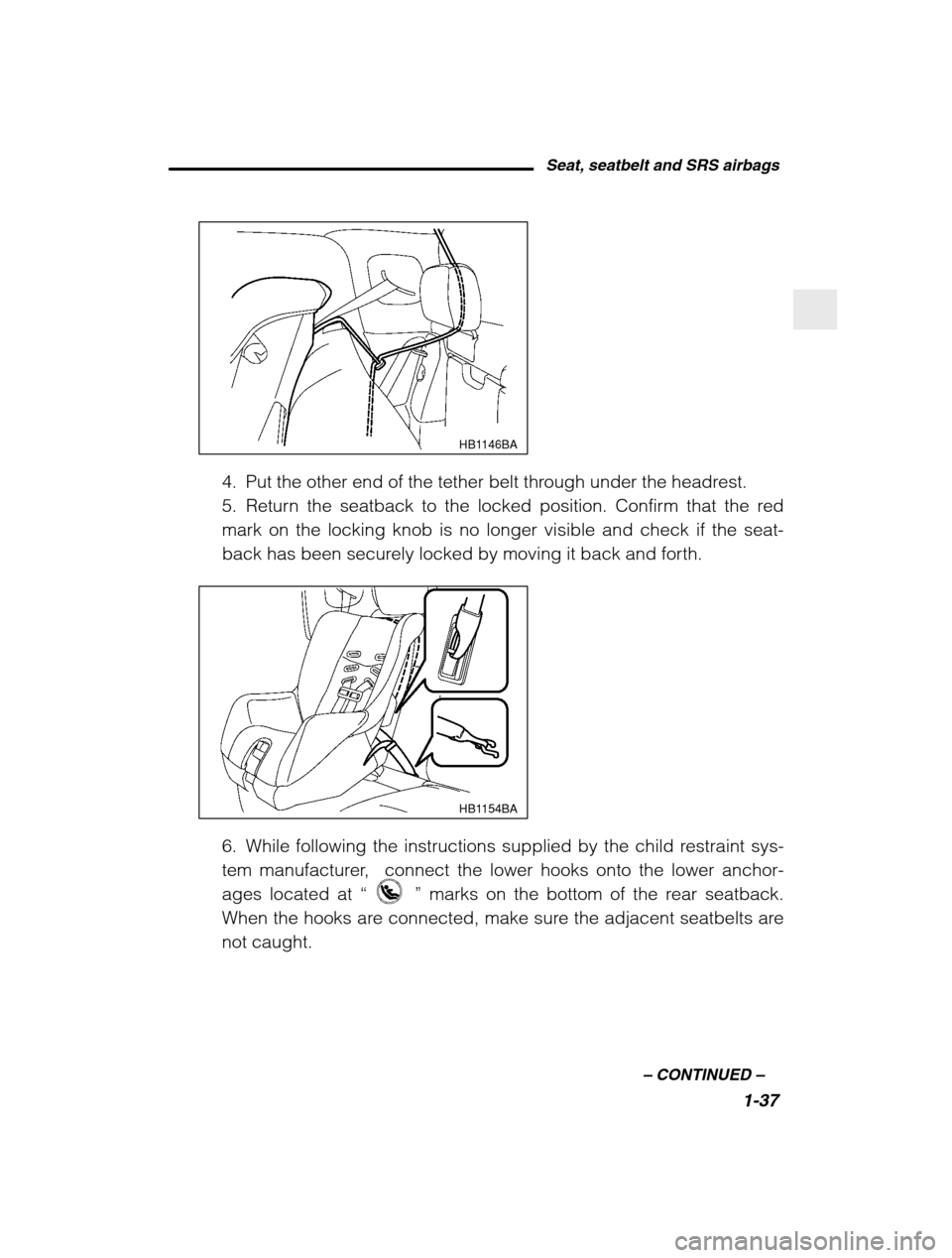
Seat, seatbelt and SRS airbags1-37
–
CONTINUED –
HB1146BA
4. Put the other end of the tether belt through under the headrest.
5. Return the seatback to the locked position. Confirm that the redmark on the locking knob is no longer visible and check if the seat-
back has been securely locked by moving it back and forth.
HB1154BA
6. While following the instructions supplied by the child restraint sys-
tem manufacturer, connect the lower hooks onto the lower anchor-ages located at “
” marks on the bottom of the rear seatback.
When the hooks are connected, make sure the adjacent seatbelts are not caught.
Page 62 of 400
![SUBARU BAJA 2003 1.G Repair Manual 1-38
HB1131BA
7. [If your child restraint system is of a flexible attachment type
(which uses tether belts to connect the child restraint system properlyto the lower anchorages)]
While pushing the c SUBARU BAJA 2003 1.G Repair Manual 1-38
HB1131BA
7. [If your child restraint system is of a flexible attachment type
(which uses tether belts to connect the child restraint system properlyto the lower anchorages)]
While pushing the c](/img/17/7188/w960_7188-61.png)
1-38
HB1131BA
7. [If your child restraint system is of a flexible attachment type
(which uses tether belts to connect the child restraint system properlyto the lower anchorages)]
While pushing the child restraint into the seat cushion, pull both left
and right lower tether belts up to secure the child restraint system
firmly by taking up the slack in the belt.
HB1147BA
8. Pull the upper tether belt straight up to secure the child restraint
system firmly by taking up the slack in the belt.
9. Put the loose end of the tether belts behind the seatback.
10. To remove the child restraint system, follow the reverse proce-
dures of installation.
If you have any question concerning proper child restraint system
installation, ask your SUBARU dealer.
Page 63 of 400
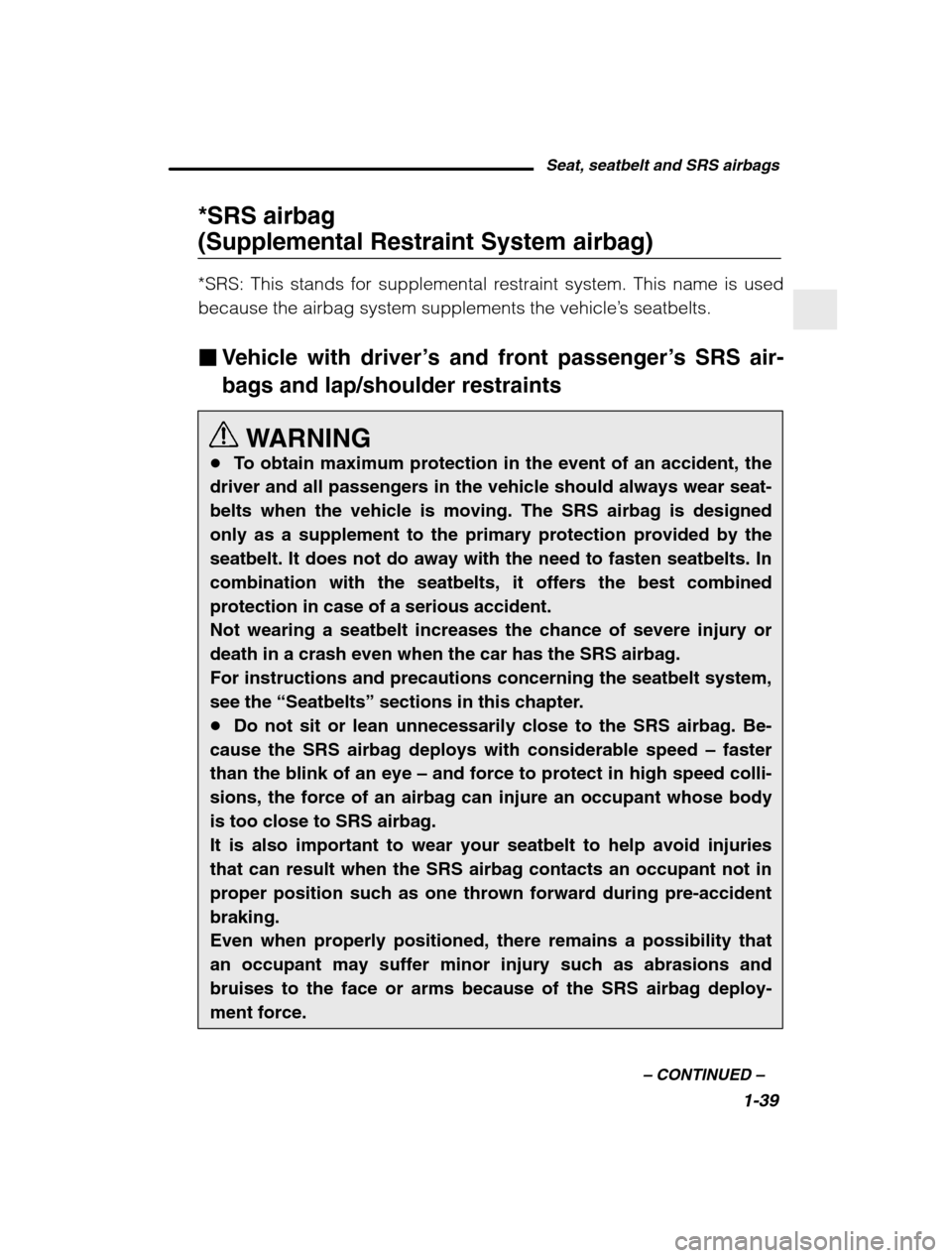
Seat, seatbelt and SRS airbags1-39
–
CONTINUED –
*SRS airbag (Supplemental Restraint System airbag)
*SRS: This stands for supplemental restraint system. This name is used because the airbag system supplements the vehicle ’s seatbelts.
� Vehicle with driver ’s and front passenger ’s SRS air-
bags and lap/shoulder restraints
WARNING
� To obtain maximum protection in the event of an accident, the
driver and all passengers in the vehicle should always wear seat-belts when the vehicle is moving. The SRS airbag is designed
only as a supplement to the primary protection provided by the
seatbelt. It does not do away with the need to fasten seatbelts. In
combination with the seatbelts, it offers the best combinedprotection in case of a serious accident.Not wearing a seatbelt increases the chance of severe injury ordeath in a crash even when the car has the SRS airbag.
For instructions and precautions concerning the seatbelt system,see the “Seatbelts” sections in this chapter.
� Do not sit or lean unnecessarily close to the SRS airbag. Be-
cause the SRS airbag deploys with considerable speed – faster
than the blink of an eye – and force to protect in high speed colli-
sions, the force of an airbag can injure an occupant whose bodyis too close to SRS airbag. It is also important to wear your seatbelt to help avoid injuriesthat can result when the SRS airbag contacts an occupant not inproper position such as one thrown forward during pre-accidentbraking.Even when properly positioned, there remains a possibility thatan occupant may suffer minor injury such as abrasions andbruises to the face or arms because of the SRS airbag deploy-ment force.
Page 64 of 400
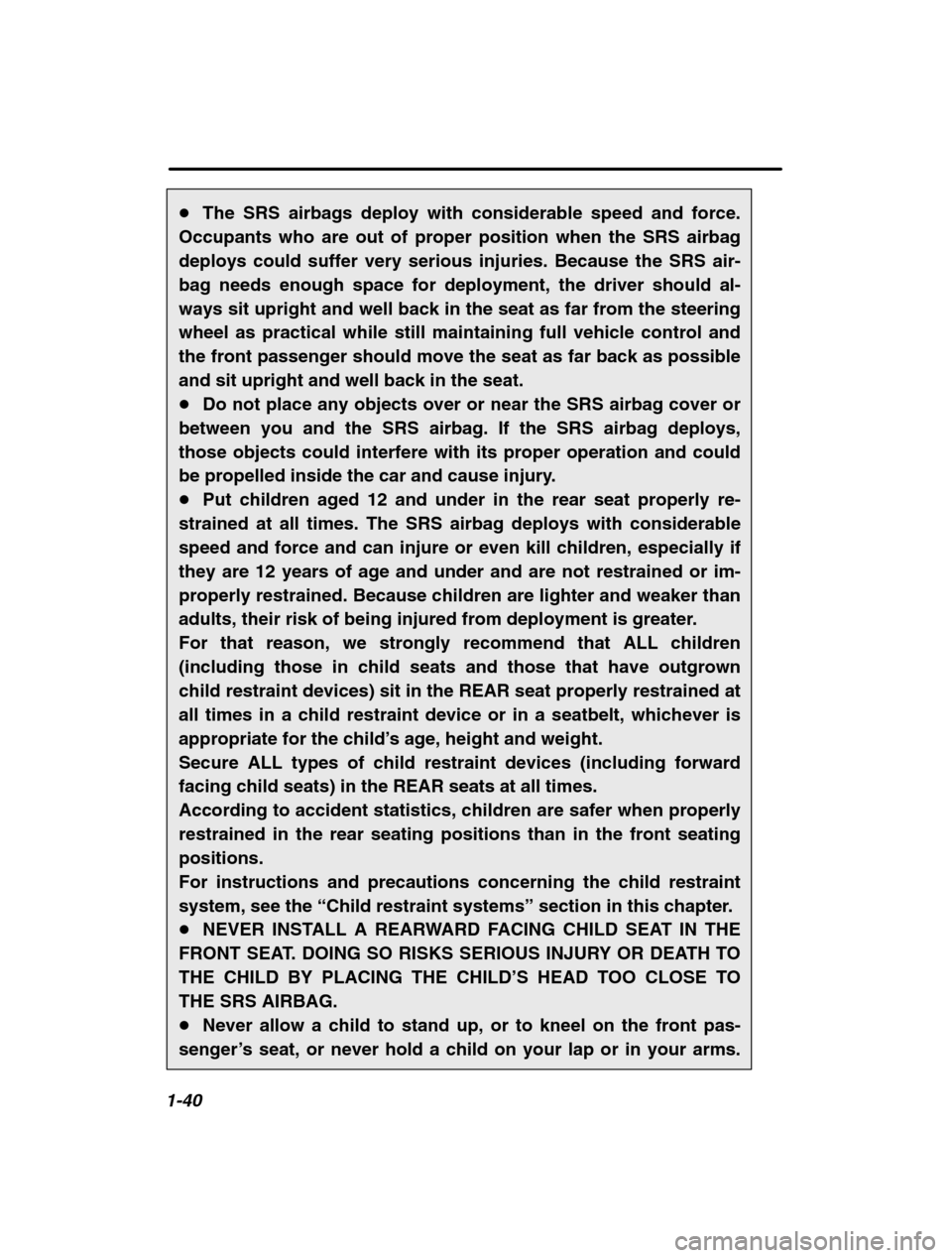
1-40
�The SRS airbags deploy with considerable speed and force.
Occupants who are out of proper position when the SRS airbag
deploys could suffer very serious injuries. Because the SRS air-bag needs enough space for deployment, the driver should al-ways sit upright and well back in the seat as far from the steeringwheel as practical while still maintaining full vehicle control and
the front passenger should move the seat as far back as possibleand sit upright and well back in the seat.� Do not place any objects over or near the SRS airbag cover or
between you and the SRS airbag. If the SRS airbag deploys,those objects could interfere with its proper operation and could
be propelled inside the car and cause injury.� Put children aged 12 and under in the rear seat properly re-
strained at all times. The SRS airbag deploys with considerablespeed and force and can injure or even kill children, especially ifthey are 12 years of age and under and are not restrained or im-properly restrained. Because children are lighter and weaker than
adults, their risk of being injured from deployment is greater.
For that reason, we strongly recommend that ALL children(including those in child seats and those that have outgrownchild restraint devices) sit in the REAR seat properly restrained atall times in a child restraint device or in a seatbelt, whichever isappropriate for the child ’s age, height and weight.
Secure ALL types of child restraint devices (including forwardfacing child seats) in the REAR seats at all times.According to accident statistics, children are safer when properlyrestrained in the rear seating positions than in the front seatingpositions.For instructions and precautions concerning the child restraint
system, see the “Child restraint systems ” section in this chapter.
� NEVER INSTALL A REARWARD FACING CHILD SEAT IN THE
FRONT SEAT. DOING SO RISKS SERIOUS INJURY OR DEATH TOTHE CHILD BY PLACING THE CHILD ’S HEAD TOO CLOSE TO
THE SRS AIRBAG.� Never allow a child to stand up, or to kneel on the front pas-
senger’ s seat, or never hold a child on your lap or in your arms.
Page 65 of 400
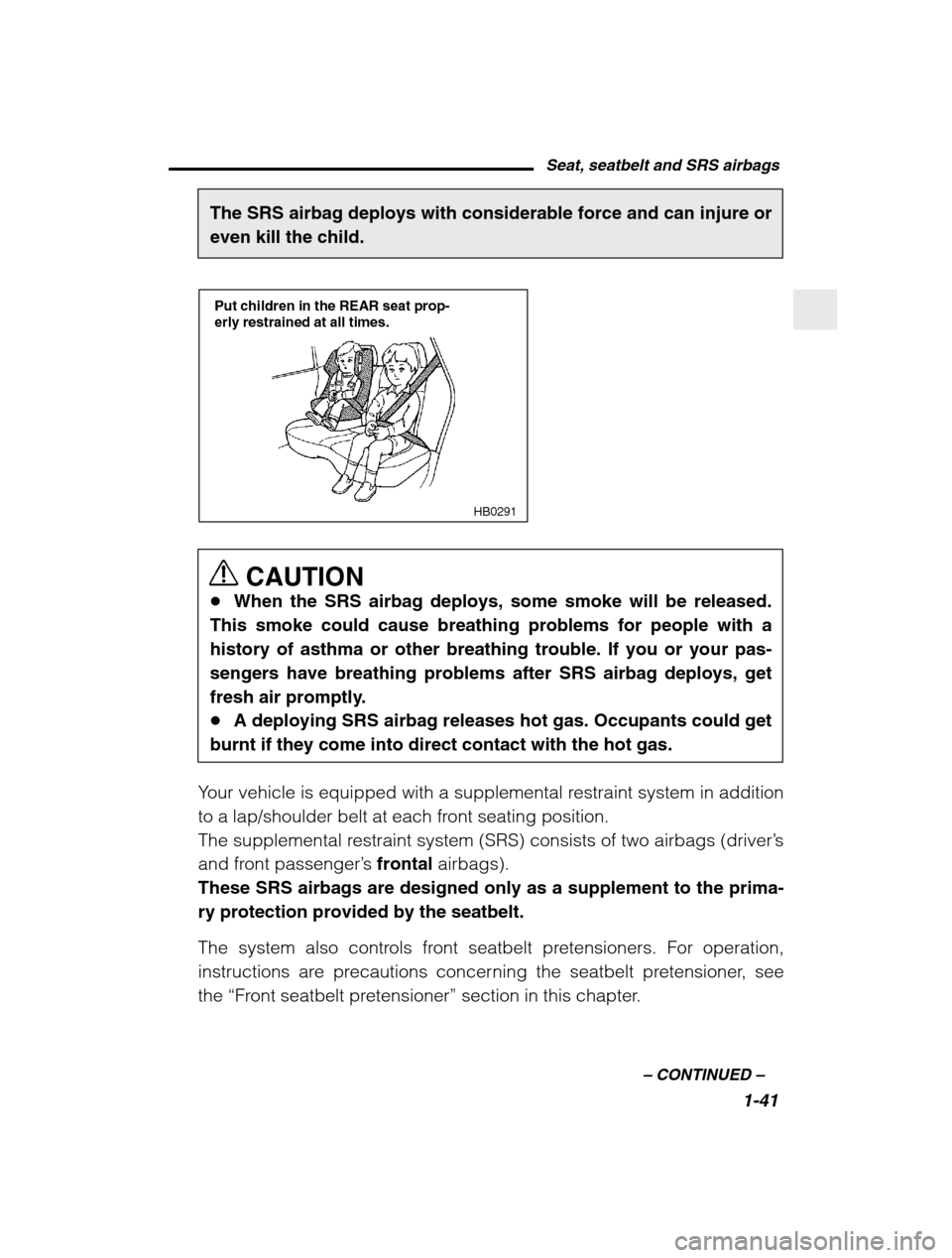
Seat, seatbelt and SRS airbags1-41
–
CONTINUED –
The SRS airbag deploys with considerable force and can injure or even kill the child.
HB0291
Put children in the REAR seat prop- erly restrained at all times.
CAUTION
� When the SRS airbag deploys, some smoke will be released.
This smoke could cause breathing problems for people with a history of asthma or other breathing trouble. If you or your pas-
sengers have breathing problems after SRS airbag deploys, get
fresh air promptly.� A deploying SRS airbag releases hot gas. Occupants could get
burnt if they come into direct contact with the hot gas.
Your vehicle is equipped with a supplemental restraint system in addition
to a lap/shoulder belt at each front seating position.
The supplemental restraint system (SRS) consists of two airbags (driver ’s
and front passenger ’s frontal airbags).
These SRS airbags are designed only as a supplement to the prima-ry protection provided by the seatbelt.
The system also controls front seatbelt pretensioners. For operation,
instructions are precautions concerning the seatbelt pretensioner, seethe “Front seatbelt pretensioner ” section in this chapter.
Page 66 of 400

1-42
NOTE When you sell your vehicle, we urge you to explain to the buyer that
it is equipped with SRS airbags by alerting him to the applicablesection in this owner’s manual.
� Components
HB1135BB
1 Airbag control module(including impact sensors)
2 Airbag module (driver ’s side)
3 Airbag module
(passenger’ s side)
4 Front sub sensor (left hand side) 5
Front sub sensor (right hand side)
6 Seatbelt pretensioner
(driver’ s side)
7 Seatbelt pretensioner
(passenger’ s side)
Page 67 of 400
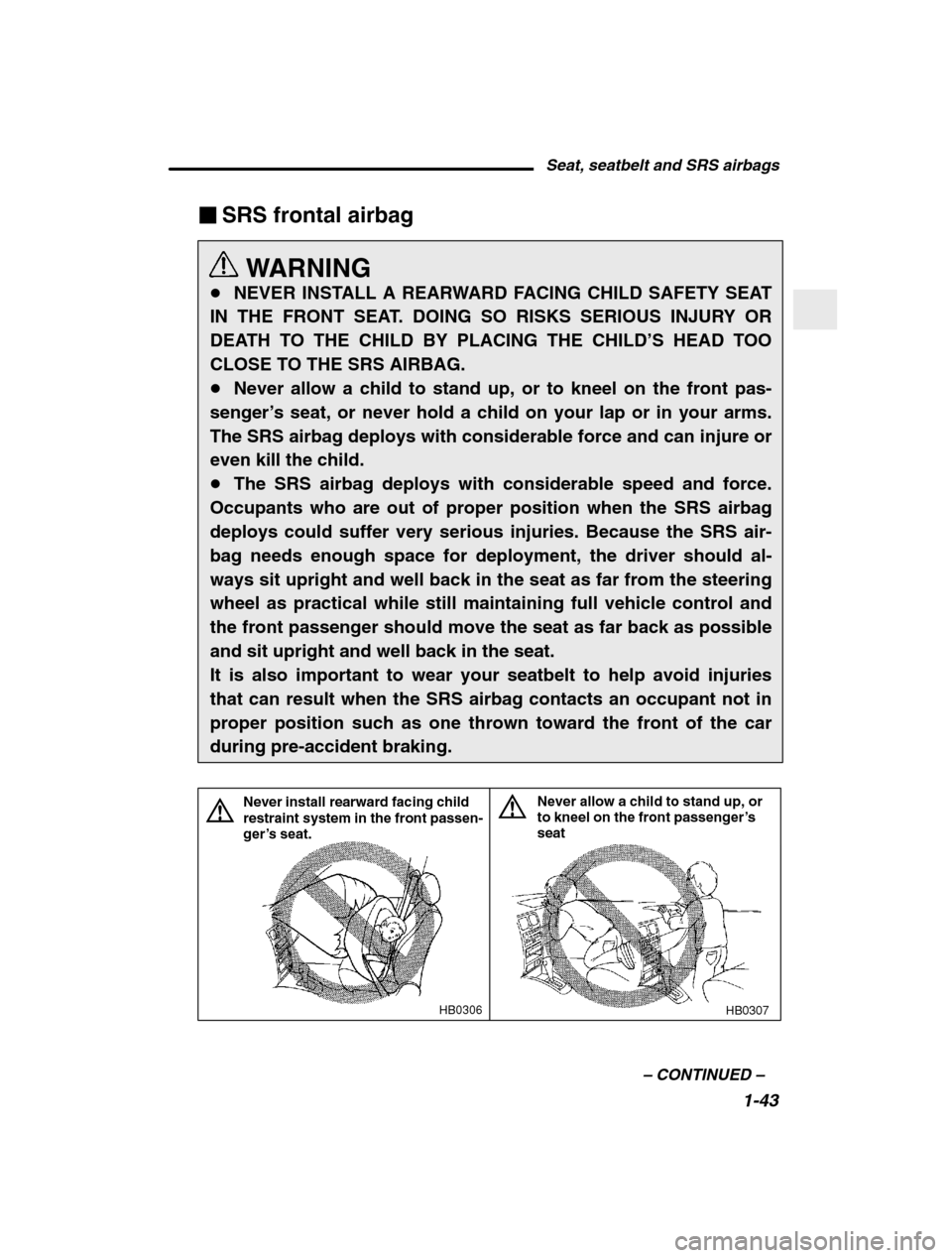
Seat, seatbelt and SRS airbags1-43
–
CONTINUED –
�SRS frontal airbag
WARNING
� NEVER INSTALL A REARWARD FACING CHILD SAFETY SEAT
IN THE FRONT SEAT. DOING SO RISKS SERIOUS INJURY OR
DEATH TO THE CHILD BY PLACING THE CHILD ’S HEAD TOO
CLOSE TO THE SRS AIRBAG.� Never allow a child to stand up, or to kneel on the front pas-
senger’ s seat, or never hold a child on your lap or in your arms.
The SRS airbag deploys with considerable force and can injure oreven kill the child.� The SRS airbag deploys with considerable speed and force.
Occupants who are out of proper position when the SRS airbag
deploys could suffer very serious injuries. Because the SRS air-bag needs enough space for deployment, the driver should al-ways sit upright and well back in the seat as far from the steeringwheel as practical while still maintaining full vehicle control and
the front passenger should move the seat as far back as possibleand sit upright and well back in the seat. It is also important to wear your seatbelt to help avoid injuriesthat can result when the SRS airbag contacts an occupant not inproper position such as one thrown toward the front of the carduring pre-accident braking.
HB0306 HB0307
Never install rearward facing child restraint system in the front passen-
ger’
s seat.
Never allow a child to stand up, or to kneel on the front passenger ’s
seat
Page 68 of 400
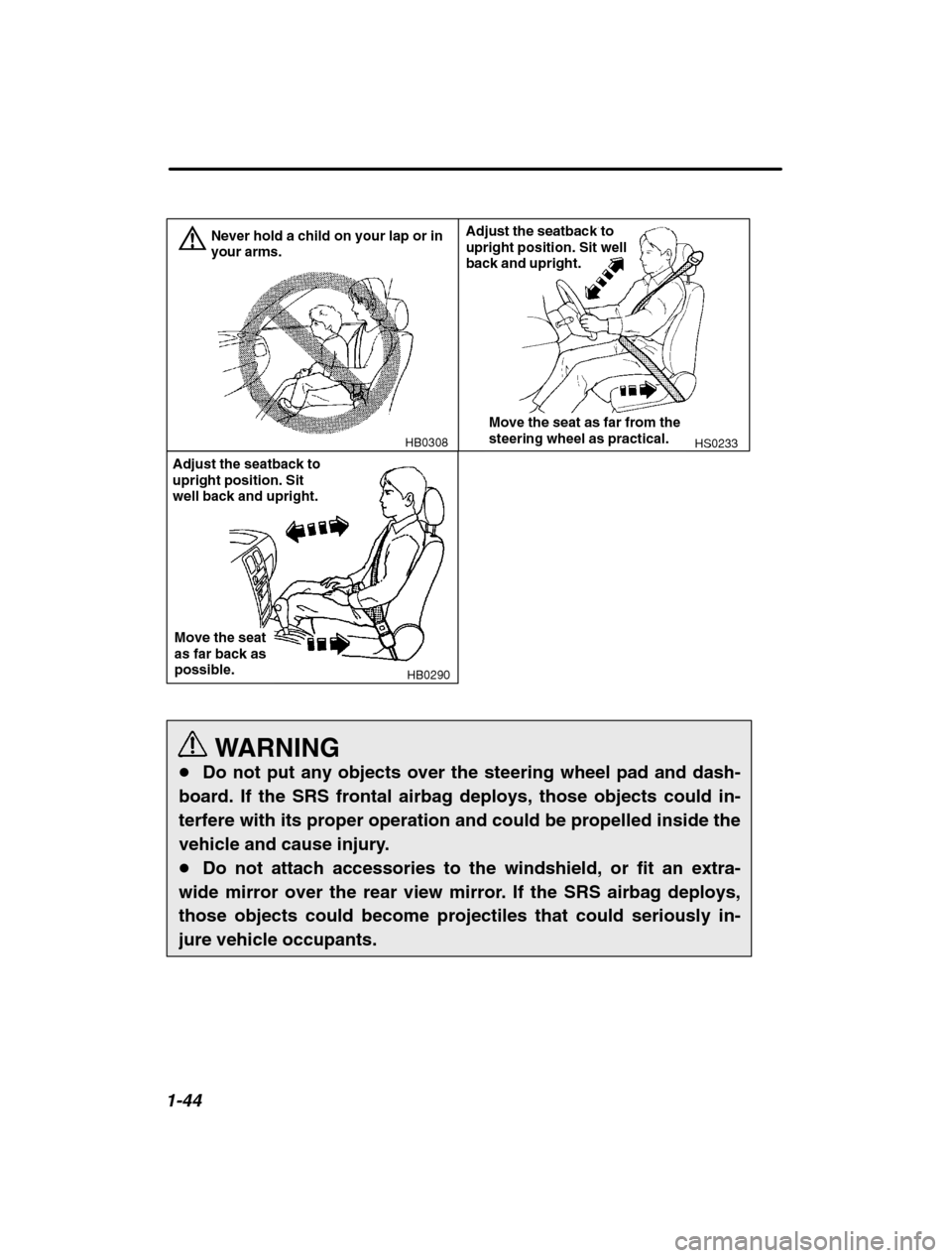
1-44
HB0308
Never hold a child on your lap or in your arms.HS0233
Adjust the seatback to upright position. Sit well back and upright.
Move the seat as far from the steering wheel as practical.
HB0290
Adjust the seatback to upright position. Sit well back and upright.
Move the seat as far back as possible.
WARNING
� Do not put any objects over the steering wheel pad and dash-
board. If the SRS frontal airbag deploys, those objects could in-
terfere with its proper operation and could be propelled inside the
vehicle and cause injury.� Do not attach accessories to the windshield, or fit an extra-
wide mirror over the rear view mirror. If the SRS airbag deploys,those objects could become projectiles that could seriously in-jure vehicle occupants.
Page 69 of 400
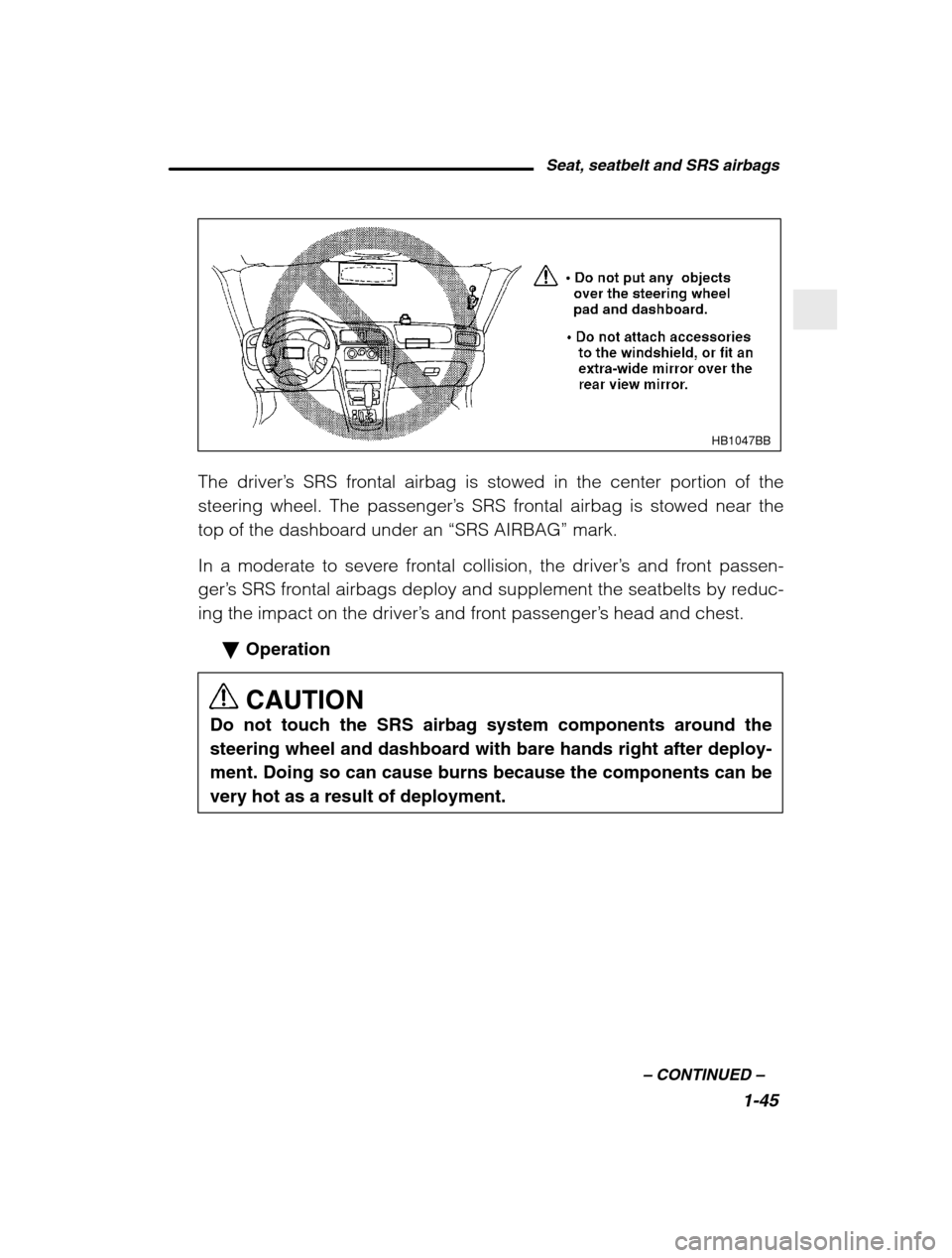
Seat, seatbelt and SRS airbags1-45
–
CONTINUED –
HB1047BB
The driver’s SRS frontal airbag is stowed in the center portion of the
steering wheel. The passenger ’s SRS frontal airbag is stowed near the
top of the dashboard under an “SRS AIRBAG ” mark.
In a moderate to severe frontal collision, the driver ’s and front passen-
ger’ s SRS frontal airbags deploy and supplement the seatbelts by reduc-
ing the impact on the driver ’s and front passenger ’s head and chest.
� Operation
CAUTION
Do not touch the SRS airbag system components around the steering wheel and dashboard with bare hands right after deploy-ment. Doing so can cause burns because the components can bevery hot as a result of deployment.
Page 70 of 400

1-46
SRS airbags deploy as soon as a collision occurs. After deployment, SRS airbags start to deflate immediately so that the driver’s
vision is not obstructed.
OM-H0384
Driver’
s side Passenger ’s side
The SRS airbag can function only when the ignition switch is in the
“ON” position.
If the front sub sensors inside the both front fenders and the impact
sensors in the airbag control module detect a certain predetermined
amount of force during a frontal collision, the control module sends
signals to the frontal airbag modules instructing them to inflate the
SRS frontal airbags. Then both airbag modules produce gas, whichinstantly inflates driver ’s and passenger ’s SRS frontal airbags. After
the deployment, the SRS airbags immediately start to deflate so thatthe driver ’s vision is not obstructed. The time required from detecting
impact to the deflation of the SRS airbag after deployment is shorter
than the blink of an eye.
The front passenger ’s SRS frontal airbag deploys together with driv-
er’ s SRS frontal airbag even when no one occupies the front passen-
ger’ s seat.
When the SRS frontal airbags deploy, the driver ’s and front passen-
ger’ s seatbelt pretensioners operate at the same time.
Although it is highly unlikely that the SRS airbag would activate in a
non-accident situation, should it occur, the SRS airbag will deflate
quickly, not obscuring vision and will not interfere with the driver ’s
ability to maintain control of the vehicle.